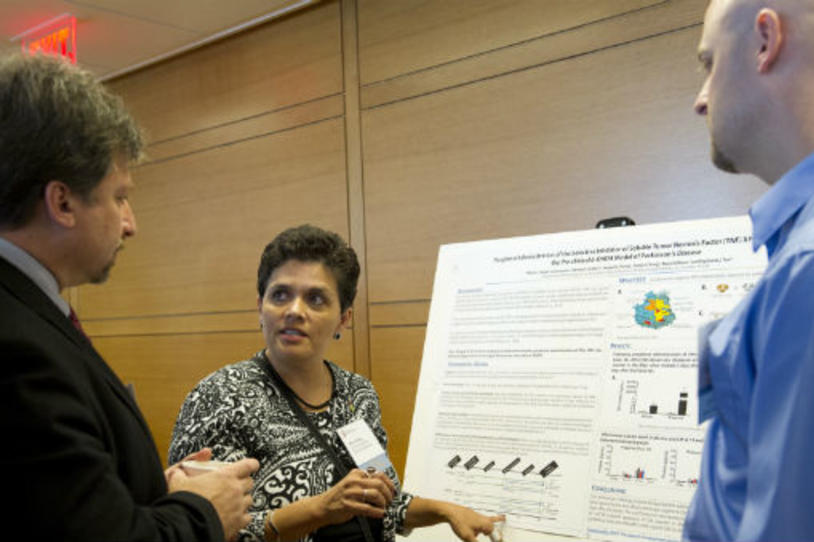
Each Monday at The Michael J. Fox Foundation, the Research Programs and Research Operations teams gather to share updates with each other on our grants and initiatives and troubleshoot issues at what we call the “PrOps” meeting. Earlier this week, the meeting had a special theme; each attendee shared a few Foundation accomplishments they were proudest of in 2013 and the promising initiatives they’re looking forward to in the new year.
Our CEO Todd Sherer, PhD, told staff, “We built momentum in our research efforts again this year, and with continued innovation in the year to come, we’re moving closer to finding a cure.”
Here’s what the neuroscience- and business-trained experts who manage our research efforts called out:
1. MJFF funded more research in 2013 than in any year prior. We gave out more than $70 million to new and promising research thanks to the amazing generosity of our donors.
“What we’ve spent this money on is the most promising science and projects that will make a difference in the lives of patients with this disease.” – Alison Urkowitz, vice president of research operations
2. We’re supporting major projects targeting alpha-synuclein. Industry is demonstrating renewed interest in therapies to clear this protein that clumps in the brains of Parkinson’s disease. This year we funded many alpha-synuclein projects, and the AFFiRiS AG vaccine trial testing a “vaccine” approach to blocking toxic alpha-synuclein clumping is on track to release results in early 2014.
3. More patients are exploring research participation and signing up for clinical studies. We know one of the biggest hurdles to advancing clinical research is recruiting patient participants (and controls). This year we launched our clinical trials fairs in Chicago, New York and San Francisco, and we have many more planned for 2014.
“Hundreds of interested Parkinson’s patients and their loved ones came to the trials fairs and the research teams there reported great leads for subjects for their studies.” – Sohini Chowdhury, senior vice president of research partnerships
4. PPMI achieved its first milestones and expanded its efforts. The Parkinson’s Progression Markers Initiative finished recruitment of its original cohort and expanded to recruit individuals with PD risk factors and include eight more clinical sites. The study investigators published their first paper, and baseline results are expected in early 2014.
5. It was a big year for open-access data and resource-sharing. The LRRK2 Cohort Consortium joined PPMI by opening its doors to data and biospecimen requests from scientists around the globe. The first study using PPMI data was published, and we’re up to more than 126,000 data downloads and 30 requests for biospecimens from the landmark biomarkers study.
“The more people looking at the data, the higher the likelihood of discovery. Collaborative methods speed research by eliminating the need for each research team to separately collect and characterize data and samples. And the rigorous standardization of PPMI enables disparate teams to more easily compare results and replicate promising findings.” – Mark Frasier, PhD, vice president of research programs
6. We’re learning from what didn’t go as planned. Ceregene, Inc. announced disappointing results out of its Phase IIb gene therapy trial of trophic factor neurturin. Many questions about the future of trophic factor research remain such as whether treating earlier stage patients may provide more benefit. MJFF continues to support and monitor other trophic factor therapies in pre-clinical and clinical stages and is planning to convene leading field experts on this topic in 2014.
7. Our PD Therapeutics Conference sold out this year. More industry, academic and Foundation leaders than at any of our previous conferences gathered to present on the latest findings and to forge and foster collaborative relationships to keep data and information flowing, which is critical to faster progress.
8. The MJFF Tools Program grew to provide working scientists with more valuable pre-clinical resources that speed discovery and drug development. The Parkinson’s Disease Research Tools Consortium launched to build on what’s currently available.
“It’s a good indication that we’re putting out valuable resources for the field when people are reaching out and want to get their hands on them.” – Meredith Haupt, associate director of research operations
9. MJFF continues contributing significantly to research and nonprofit thought leadership. The Foundation exists to overcome obstacles and fill gaps for the field. We think there’s a lot to learn from our collaborative, open-access model, and we’ve shared our vision through op-eds, media opportunities and meeting presentations throughout the year.
“Industry and academia turn to us for more than just grants. Our unique position in the research landscape has allowed us to share our business model and network non-traditional partners.” – Brian Fiske, vice president of research programs
10. We’ve grown significantly. The Foundation has welcomed staff across departments as we begin new partnerships and grow our funding programs.
“In my old lab we were all impressed by the speed between applying for a grant and starting the project once the proposal was accepted by MJFF. It’s fascinating to see inside the clock, how the gears are turning to make that speed possible and keep up the urgency of our pursuit of the cure.” – Terina Martinez, PhD, associate director of research programs
Want more? Watch our 2013 Research in Review Webinar on demand.
